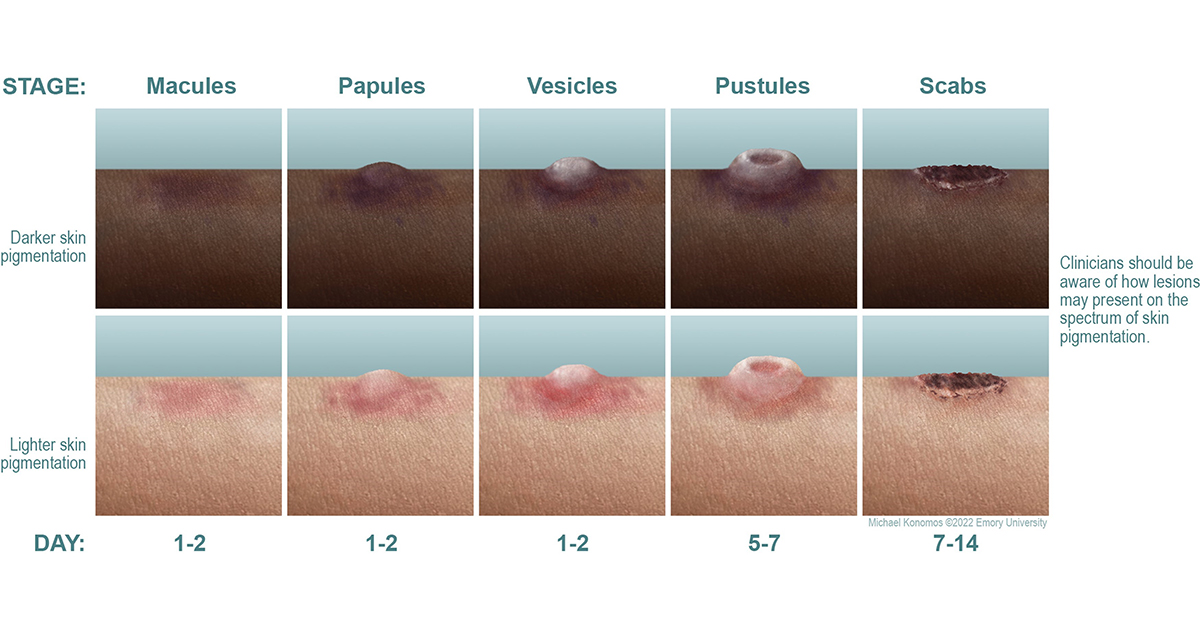How does mpox start? Plus, 5 pictures to show how the bumps progress

Due to growing awareness about the mpox virus, how it spreads, and community involvement, the number of confirmed cases has been trending downward in recent weeks. In this article, we will address more common questions and describe how the mpox rash looks and what to expect at each stage of progression.
How does mpox start?
Mpox can be tricky to diagnose because there's no uniform way it first appears. While some people experience flu-like symptoms before a rash is visible, others may see the rash appear first and feel the flu-like symptoms later – or not at all.
Depending on where the rash appears, some mpox sores begin where pain can be felt but not necessarily seen. This is especially true in cases where the rash starts in the mouth or internal areas of the anus or genitals.
In short, there's no one-size-fits-all way to identify how mpox starts, but we do know how it spreads and how to protect yourself from infection.
When is the mpox rash no longer contagious?
The mpox rash is contagious at every stage until the skin lesions are healed with new skin replacing the scabs.
"Although each individual lesion may go through a typical pattern of progression, there are often multiple lesions, each at different stages of progression, at any given time," says Sara Hurtado Bares, MD, Nebraska Medicine infectious diseases physician. "While a skin lesion may first appear in one area, new lesions often appear as the illness progresses, and it often takes up to four weeks from symptoms beginning to when patients are no longer contagious."
What the rash looks like and what to expect at each stage
Stage one: Macules
Macules appear like flat, round pink spots with no bump, lasting for one to two days.
Stage two: Papules
Papules go from a flat, pink spot to a raised bump that typically lasts one to two days.
Stage three: Vesicles
In this stage, the bumps go from raised to filled with a clear fluid for another one to two days.
Stage four: Pustules
Vesicles progress from a clear fluid-filled bump to an opaque pus bump. The pus bump enlarges, gets firmer, and can develop a small divot in the center. The bump may begin forming a small, crusted scab in the center. This stage takes about a week or so.
Stage five: Scabs
Over a week or two, the pus bumps will crust and scab over. Scabs will remain for about a week before beginning to fall off.
If you are concerned about potential scarring, read about seven ways to protect your skin from scarring. "There are also effective over-the-counter treatments for scar treatment, including silicone scar sheets and ointments," says Jennifer Adams, MD, board-certified dermatologist. "These can help decrease the appearance of scars, especially in the early stages. Avoid topical steroid creams and ointments. If you are being seen for a chronic skin condition like eczema or other problems, talk with your doctor about how to reduce the risk of spreading."
Is it a mpox rash or something else?
Especially in the early stages, it's not easy to tell between a mpox rash and other sorts of skin bumps. If you've been in close contact with a person with a confirmed mpox diagnosis or are considered at higher risk of exposure, reach out to a doctor.
An easy way to get help with a rash you're not sure about? Set up a virtual visit (E-Visit) to consult with a Nebraska Medicine dermatologist.
- Log into One Chart
- Click on upper left-hand "menu"
- Click on "E-visit"
- Choose the "skin concern" option and follow instructions to send a photo and information to a dermatologist for prompt evaluation
Learn more by visiting other helpful mpox resources.







